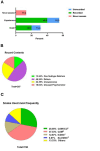Knowledge, attitude, and practice toward delirium and subtype assessment among Chinese clinical nurses and determinant factors: A multicentre cross-section study
- PMID: 36819944
- PMCID: PMC9929153
- DOI: 10.3389/fpsyt.2022.1017283
Knowledge, attitude, and practice toward delirium and subtype assessment among Chinese clinical nurses and determinant factors: A multicentre cross-section study
Erratum in
-
Corrigendum: Knowledge, attitude, and practice toward delirium and subtype assessment among Chinese clinical nurses and determinant factors: A multicentre cross-section study.Front Psychiatry. 2024 Sep 3;15:1483648. doi: 10.3389/fpsyt.2024.1483648. eCollection 2024. Front Psychiatry. 2024. PMID: 39290306 Free PMC article.
Abstract
Background: Delirium, a confused transient state of consciousness, can be divided into hyperactive, hypoactive, mixed, and no motor subtypes, according to different clinical manifestations. Several studies have investigated delirium subtypes in the knowledge dimension, but few studies have investigated delirium subtype in the attitude and practice dimensions. The barriers, knowledge sources, and practice details regarding subtype assessment are unclear.
Objectives: This study had three objectives. First, we planned to investigate the KAP status regarding delirium and subtypes for nurses. Second, we wanted to identify factors affecting clinical nurses' KAP scores. Third, this study expected to explore more details regarding delirium and subtypes assessment, including assessment barriers, assessment instruments, and knowledge sources.
Methods: This multicentre cross-section study was conducted in 10 tertiary hospitals in three provinces, China, from January to April 2022. We investigated 477 nurses from six departments with a high prevalence. The self-developed KAP questionnaire regarding delirium and subtypes assessment had four parts: knowledge, attitude, practice, and source. Its reliability and validity were verified effectively by 2-round Delphi expert consultation.
Results: A total of 477 nurses from the general intensive care unit (ICU), specialty ICU, orthopedics, thoracic surgery, operating room, and geriatrics were 28.3, 22.4, 22.2, 10.5, and 5.2%, respectively. The total KAP score regarding delirium and subtypes assessment was 60.01 ± 6.98, and the scoring rate was 73.18%. The scoring rate for knowledge, attitude, and practice was 58.55, 83.94, and 51.70%, respectively. More than half (54.1%) were unaware of the delirium subtypes assessment instruments. A total of 451 (94.6%) participants recognized the importance of nursing work for delirium prevention. A total of 250 (52.4%) nurses occasionally or sometimes assessed delirium subtypes, and 143 (30.0%) never assessed for delirium subtypes. We found that age, department, technical title, familiarity with delirium, familiarity with delirium subtypes, delirium training, and subtype training affected the total KAP scores. ICU nurses achieved the highest scores.
Conclusion: Chinese nurses' KAP status regarding delirium and subtypes assessment were barely acceptable, and the attitude score was positive, but knowledge and practice needed improvement. Meanwhile, the department was one of the significant KAP factors, and ICU nurses did better in delirium and subtype assessment in knowledge and practice dimension than other departments. Systematic and scientific training processes including subtype content and assessment tools are required. Experience still drives nurses' assessments of delirium and subtype. Adding the delirium assessment into routine tasks should be considered.
Keywords: assessment frequency; delirium; delirium subtypes; measurements; nursing assessment.
Copyright © 2023 Zhou, Zheng, Huang, Zhang, Zhang, Yang, Wu and Gan.
Conflict of interest statement
The authors declare that the research was conducted in the absence of any commercial or financial relationships that could be construed as a potential conflict of interest.
Figures





Similar articles
-
Knowledge, attitude and practice regarding hypoactive delirium among ICU nurses: A nationwide cross-sectional study.Nurse Educ Pract. 2023 Oct;72:103749. doi: 10.1016/j.nepr.2023.103749. Epub 2023 Aug 19. Nurse Educ Pract. 2023. PMID: 37660518
-
Development and validation of nurse's assessment ability questionnaire in delirium subtypes: Based on Delphi expert consensus.PLoS One. 2024 Jan 23;19(1):e0297063. doi: 10.1371/journal.pone.0297063. eCollection 2024. PLoS One. 2024. PMID: 38261557 Free PMC article.
-
Knowledge, Attitude, and Practice Levels of Nurses in Primary Hospitals Regarding Elderly Subsyndromal Delirium: Assessment and Development of a Network-Based Tiered Training Program.Br J Hosp Med (Lond). 2025 May 23;86(5):1-17. doi: 10.12968/hmed.2024.1002. Epub 2025 May 8. Br J Hosp Med (Lond). 2025. PMID: 40405859
-
Development and validation of knowledge, attitude and practice questionnaire for pediatric nurses to prevent central venous device-related thrombosis in hospitalized children.Nurse Educ Pract. 2023 Aug;71:103694. doi: 10.1016/j.nepr.2023.103694. Epub 2023 Jun 26. Nurse Educ Pract. 2023. PMID: 37453368 Review.
-
Development and testing of a questionnaire assessing knowledge, attitudes, and practices to prevent unplanned oral extubation.Nurs Crit Care. 2024 Mar;29(2):366-384. doi: 10.1111/nicc.12953. Epub 2023 Aug 17. Nurs Crit Care. 2024. PMID: 37592820 Review.
Cited by
-
Factors Influencing Nurses' Knowledge About Delirium in Acute Care Settings in Hail Region, Saudi Arabia: A Cross-Sectional Study.Risk Manag Healthc Policy. 2024 Dec 21;17:3257-3266. doi: 10.2147/RMHP.S494402. eCollection 2024. Risk Manag Healthc Policy. 2024. PMID: 39723433 Free PMC article.
-
Investigation of the factors affecting delirium evaluation by intensive care nurses: a cross-sectional descriptive study.BMC Nurs. 2025 Jul 24;24(1):968. doi: 10.1186/s12912-025-03638-0. BMC Nurs. 2025. PMID: 40707935 Free PMC article.
-
A Cross-Sectional Survey on Nurses' Utilization of Risk Assessment and Screening for Postoperative Delirium in Older Patients Following Hip Fracture Surgery in Tertiary Hospitals in Jiangsu Province, China.Risk Manag Healthc Policy. 2024 Oct 19;17:2457-2464. doi: 10.2147/RMHP.S481087. eCollection 2024. Risk Manag Healthc Policy. 2024. PMID: 39450282 Free PMC article.
-
Dietary knowledge-attitude-practice status in hemodialysis patients: a latent profile analysis.BMC Public Health. 2024 Mar 18;24(1):836. doi: 10.1186/s12889-024-18066-z. BMC Public Health. 2024. PMID: 38500120 Free PMC article.
-
Appraising the Factors Associated with Delirium Care Behaviours and Barriers to Their Assessment Among Clinical Nurses: A Cross-Sectional Study.Int J Environ Res Public Health. 2024 Nov 27;21(12):1582. doi: 10.3390/ijerph21121582. Int J Environ Res Public Health. 2024. PMID: 39767424 Free PMC article.
References
LinkOut - more resources
Full Text Sources
Miscellaneous

